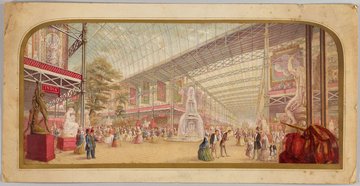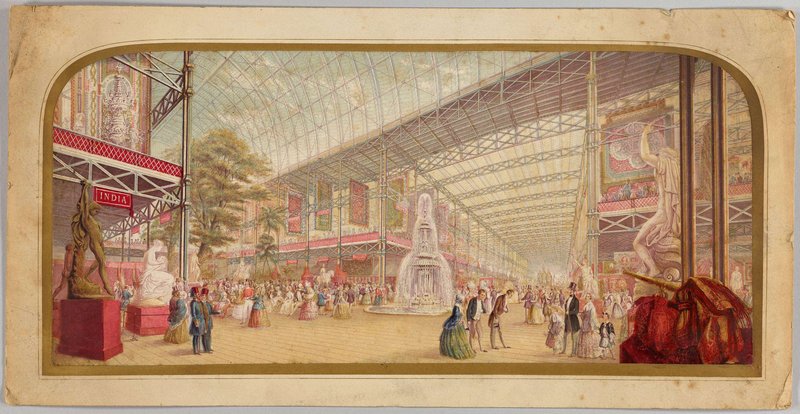
Great Exhibition, 1851
‐
A large international exhibition that included a sizeable India section and displayed the Koh-i-Noor diamond
Place of event
‘Crystal Palace’, Hyde Park, London
About
The ‘Great Exhibition of the Works of Industry of All Nations’ was held at the newly built Crystal Palace in London between May and October 1851. Designed in collaboration with Prince Albert (Queen Victoria’s consort), it was opened by Queen Victoria on 1 May 1851. The exhibition included over 100,000 exhibits from around the world, divided broadly into raw materials, machinery, manufactures and the fine arts. While it included displays from all around the world, the prominence of items from parts of the British empire were integral to showcasing the breadth and reach of imperial trade and power. It included the India Court, which was placed centrally, with more than 24,000 square feet allocated to India. John Forbes Royle, a botanist in India, was in charge of assembling goods for the Court. A large stuffed elephant (on loan from Saffron Walden Museum in Essex) alongside furniture, raw materials, textiles, handicrafts, art and other goods were put on display. It also included life-size models of Indian people.
One of the most famous features of the exhibition was the display of the Koh-i-Noor diamond. The diamond had been confiscated from Maharaja Ranjit Singh’s Sikh empire by the East India Company in 1850 and taken into possession by Queen Victoria. Under tight security, it was displayed in a golden cage but initial commentators were disappointed by its cut. The display was reworked to shed more light on it and at the end of the exhibition the diamond was taken back to the Royal Vaults. The Koh-i-Noor has remained in the possession of the UK Royal Family ever since.
The exhibition was a huge success in terms of visitor numbers. Over 6 million people attended over the five and a half months it was open. The profits were used to establish the South Kensington Museum, which was renamed the Victoria and Albert Museum in 1899. The 1851 Great Exhibition was also a huge influence on subsequent imperial exhibitions held in Britain, such as the 1886 Colonial and Indian Exhibition, as well as internationally, such as the 1855 Madras Exhibition, in terms of scale and scope and also the way in which exhibits were classified and organized. The glass ‘Crystal Palace’ that held the exhibition was relocated to Sydenham Hill in south London, which now bears the name Crystal Palace, although the palace was destroyed by fire in 1936. The Great Exhibition’s centenary was marked by the 1951 Festival of Britain at a new site in the Southbank Centre, London.
East India Company
Prince Albert, John Forbes Royle, Queen Victoria.
Anand, Anita and Dalrymple, William, Koh-i-Noor: The History of the World's Most Infamous Diamond (London: Bloomsbury, 2017)
Auerbach, Jeffrey, The Great Exhibition of 1851: A Nation on Display (New Haven, CT: Yale University Press, 1999)
Auerbach, Jeffrey A., and Hoffenberg, Peter H. (eds) Britain, the Empire, and the World at the Great Exhibition of 1851 (Aldershot: Ashgate, 2008)
Hoffenberg, Peter H., An Empire on Display: English, Indian, and Australian Exhibitions from the Crystal Palace to the Great War (Berkeley: University of California Press, 2001)
Joshi, Priti, ‘Miles Apart: The India Display at the Great Exhibition’, Museum History Journal 9.2 (2016), pp. 136–52
Official Descriptive and Illustrated Catalogue / Great Exhibition of the Works of Industry of All Nations, 1851 (London: Royal Commission, 1851)
L/AG/1/1/33/f.283(1), Great Exhibition 1851, East India Company ledgers, India Office Records, Asian and African Studies Reading Room, British Library, St Pancras
L/AG/1/1/34/f.217, Great Exhibition 1851, East India Company ledgers, India Office Records, Asian and African Studies Reading Room, British Library, St Pancras
Mss Eur F195, Copies of papers collected by Ray Desmond for writing his book on 'The India Museum 1801-1879' (London 1982), Asian and African Studies Reading Rooms, British Library, St Pancras
Special Collections, The London Archives, London

The interior of the Great Exhibition by George Baxter, 1851
Photo by Birmingham Museums Trust, licensed under CC0
Image credit
The interior of the Great Exhibition by George Baxter, 1851
Photo by Birmingham Museums Trust, licensed under CC0
